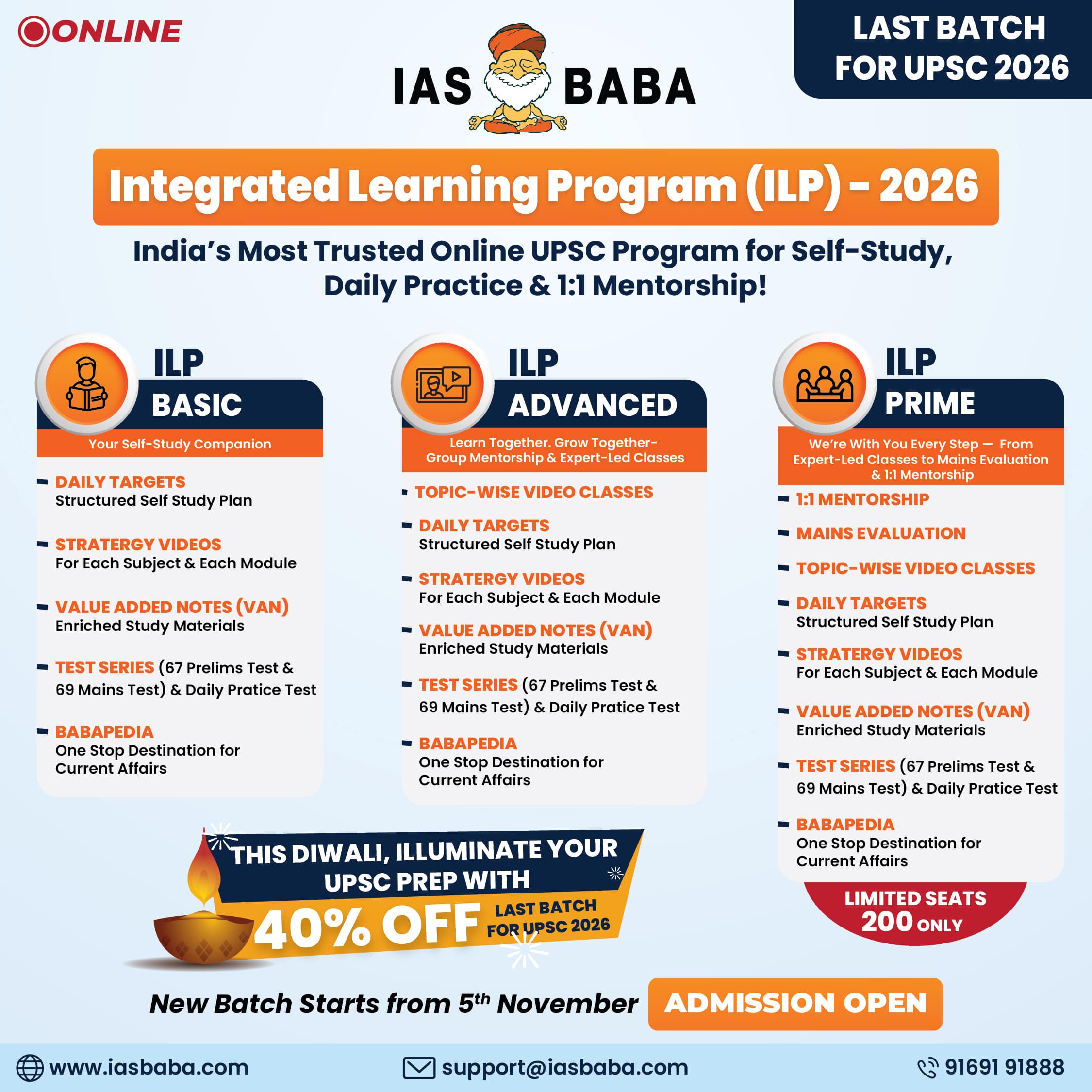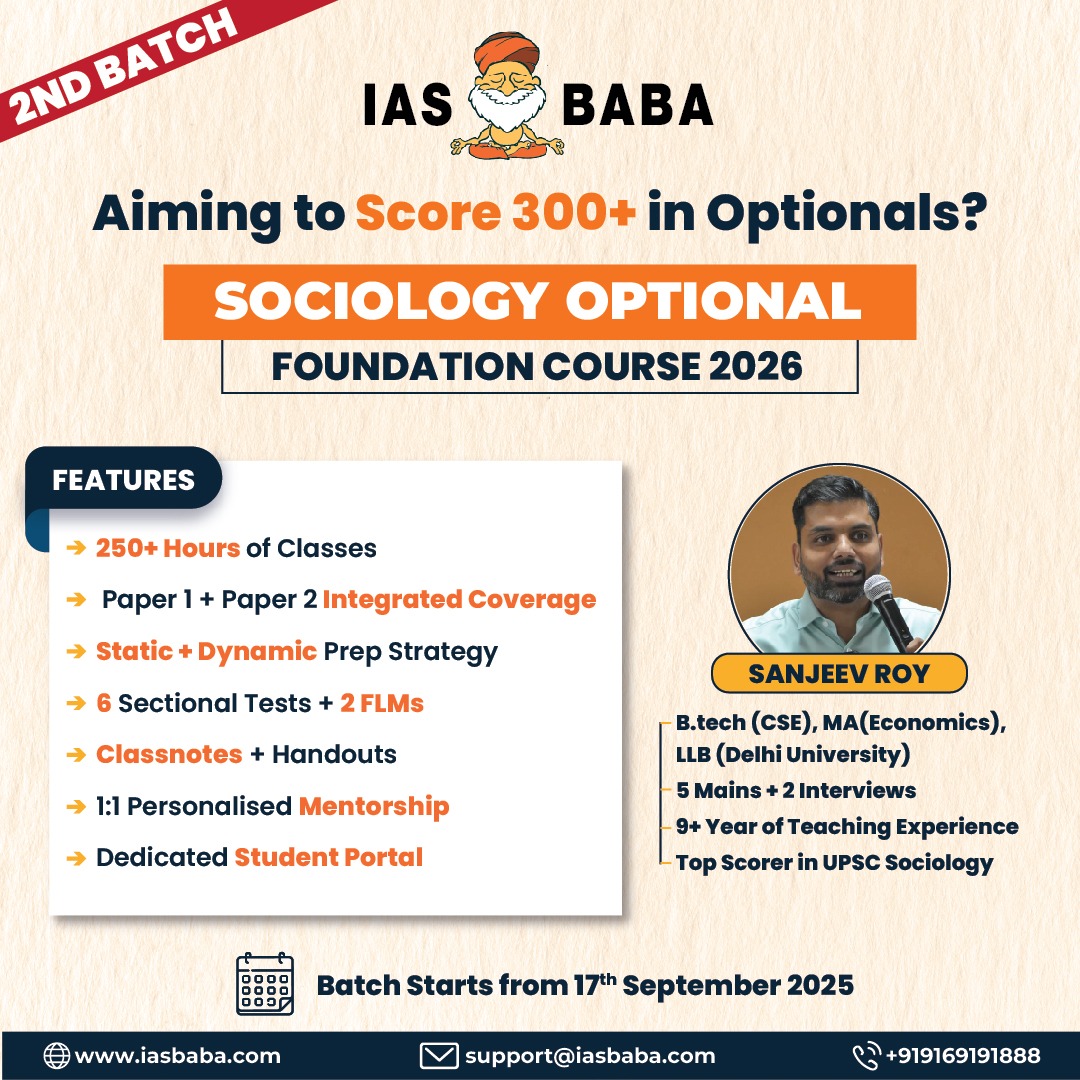IASbaba's Daily Current Affairs Analysis
rchives
(PRELIMS Focus)
Category: POLITY
Context: The government has reopened applications for the Production-Linked Incentive (PLI) scheme for white goods—air conditioners and LED lights—from September 15 to October 14.
The move aims to boost domestic manufacturing of components not adequately produced in India. Both new and existing investors can apply. So far, 83 applicants have committed ₹10,406 crore. Launched in April 2021, the scheme runs for seven years (2021-22 to 2028-29) with a total budget of ₹6,238 crore.
Production-Linked Incentive (PLI) Scheme
Introduction
- Launched by the Government of India in March 2020, initially for large-scale electronics manufacturing (mobile phones & components).
- Later expanded to 14 key sectors to promote Atmanirbhar Bharat (self-reliant India).
- Objective: Make India a global manufacturing hub, reduce import dependency, create jobs, strengthen supply chains, and boost exports.
Coverage
The scheme now covers 14 sectors:
- Large-scale electronics (mobiles, components)
- Pharmaceuticals & drug intermediaries
- Medical devices
- Telecom & networking products
- Food processing
- White goods (air conditioners, LED lights)
- High efficiency solar PV modules
- Advanced chemistry cell (ACC) batteries
- Automobiles & auto components
- Specialty steel
- Textile & man-made fibers
- IT hardware (laptops, tablets, servers)
- Drones & drone components
- Semiconductors & display manufacturing
Budget & Duration
- Total Outlay: ~₹1.97 lakh crore (over 7 years).
- Duration: Generally from 2020-21 to 2028-29, depending on the sector.
- Each sector has separate guidelines on eligibility, base year, and incentive slabs.
How It Works
- Incentives (usually 4%–6%) are given on incremental sales of goods manufactured in India, compared to a base year.
- Incentives decrease gradually over the years.
- Both domestic and foreign companies are eligible if they commit to minimum investment and sales targets.
Source: THE HINDU
Category: INTERNATIONAL
Context : Russia has conducted “Zapad” joint military drills with Belarus, featuring a successful Zircon hypersonic cruise missile launch in the Barents Sea and strikes by Su-34 fighter-bombers.
The exercises, described as defensive, aim to enhance coordination. The Zircon, claimed to fly at nine times the speed of sound with a range over 1,000 km, hit its target directly. The drills follow recent Russian drone incursions into Poland and NATO’s “Eastern Sentry” response.
Learning Corner:
Zircon Hypersonic Cruise Missile
- Type: Hypersonic cruise missile developed by Russia.
- Speed: Claimed to reach Mach 8–9 (8–9 times the speed of sound).
- Range: Estimated 1,000–1,500 km.
- Launch platforms: Can be launched from surface ships, submarines, and coastal launchers.
- Propulsion: Uses a scramjet engine after booster separation, allowing sustained hypersonic flight.
- Warhead: Can carry conventional or nuclear payloads.
- First tests: Reportedly conducted in 2016, with more frequent trials since 2020.
- Deployment: Russia has started integrating Zircon into its naval fleet, particularly on Admiral Gorshkov-class frigates and Yasen-class submarines.
- Strategic significance: Its speed and maneuverability make it difficult for existing air defense and missile defense systems to intercept, giving Russia a potential edge in anti-ship and land-attack roles.
Table of notable hypersonic cruise missiles, their country of origin,
| Missile Name | Country | Type | Speed | Range | Warhead | Launch Platform |
|---|---|---|---|---|---|---|
| 3M22 Zircon | Russia | Anti-ship / land-attack | Mach 8–9 | Up to 1,000 km | 300–400 kg | Submarines, surface ships, land-based |
| Kinzhal (Dagger) | Russia | Air-launched ballistic | Mach 10+ | ~2,000 km | Nuclear or conventional | MiG-31K aircraft |
| Oreshnik | Russia | Air-launched cruise | Mach 10 | Europe-wide | Conventional or nuclear | Aircraft |
| CJ-100 | China | Air-launched cruise | Mach 5+ | 300–500 km | Conventional | H-6K bomber |
| YJ-21 | China | Anti-ship cruise | Mach 6+ | 300–400 km | Conventional | Type 055 destroyer |
| HACM | USA | Air-launched cruise | Mach 8 | 1,900 km | Conventional | F-15E, F/A-18F, F-35A |
| X-51A WaveRider | USA | Experimental scramjet | Mach 6 | ~200 km | Conventional | B-52 bomber |
| BrahMos-II | India | Hypersonic cruise | Mach 7 | ~290 km | Conventional | Air, land, sea |
| Hycore | South Korea | Hypersonic cruise | Mach 5+ | 300–500 km | Conventional | Surface ships |
| Fattah | Iran | Hypersonic cruise | Mach 15 | 1,400 km | Conventional | Ground-based |
Source: THE HINDU
Category: INTERNATIONAL
Context: The Scarborough Shoal is a contested reef chain in the South China Sea, about 200 km off the Philippines’ coast and near major shipping lanes
Claimed by both the Philippines and China, it has been under China’s effective control since 2012 despite a 2016 ruling that invalidated Beijing’s broader claims. Recently, China announced a nature reserve there, fueling fears it may build a militarized island. Tensions are rising as Philippine leaders take a tougher stance, with the U.S.–Philippines Mutual Defence Treaty heightening the risk of wider conflict.
Learning Corner:
Nine-Dash Line
Definition:
The Nine-Dash Line is a demarcation used by China to claim a large part of the South China Sea. It appears on Chinese maps as nine dashes or lines that extend far south and east from the Chinese mainland, covering about 90% of the South China Sea.
Origin:
- First appeared in 1947 on a map published by the then Republic of China.
- The People’s Republic of China inherited the claim in 1949.
Features:
- The line is not internationally recognized.
- It overlaps with the exclusive economic zones (EEZs) and territorial waters of several countries:
- Vietnam
- Philippines
- Malaysia
- Brunei
- Taiwan (also claims the line)
Legal Status:
- In 2016, the Permanent Court of Arbitration (PCA) in The Hague ruled that China’s claims based on the Nine-Dash Line have no legal basis under the United Nations Convention on the Law of the Sea (UNCLOS).
- China rejected the ruling.
Strategic Importance:
- South China Sea is a major maritime trade route.
- Rich in fisheries and potential oil and gas reserves.
- Crucial for naval and geopolitical influence in the Indo-Pacific region.
India’s Perspective:
- India does not recognize the Nine-Dash Line.
- Supports freedom of navigation and rules-based maritime order.
- Engages in diplomatic and naval presence through QUAD, ASEAN dialogues, and freedom of navigation operations.
Source: THE INDIAN EXPRESS
Category: HISTORY
Context : Seventy-seven years ago, in September 1948, India launched Operation Polo to annex Hyderabad, the largest princely state that had resisted joining the Union..
The Nizam sought independence despite a Hindu majority and signed a temporary standstill agreement. Meanwhile, peasant revolts grew, and the Razakars, a private militia, violently suppressed dissent. With negotiations failing, India intervened on September 13, 1948. In a four-day campaign, the Indian Army defeated the Nizam’s forces, leading to his surrender on September 17. Hyderabad was integrated into India, first under military rule and later through elected government in 1952.
Learning Corner:
Operation Polo (1948)
- Context: At the time of Independence (1947), Hyderabad was the largest princely state, ruled by Nizam Mir Osman Ali Khan, who sought independence despite India’s appeals for integration.
- Problem:
- Majority Hindu population under a feudal system.
- Rise of Razakars, a private militia supporting the Nizam, known for violent suppression.
- Peasant revolts led by communists and local groups.
- Standstill Agreement (1947): Signed between India and Hyderabad to maintain status quo while negotiations continued.
- Trigger: Breakdown of talks and rising Razakar violence pushed the Indian government to act.
- Military Action: On 13 September 1948, India launched “Operation Polo”, a swift military campaign.
- Outcome:
- Lasted only four days.
- Nizam surrendered on 17 September 1948.
- Hyderabad was integrated into the Indian Union.
- Initially placed under military administration, later followed by elections in 1952.
Source: THE INDIAN EXPRESS
Category: ENVIRONMENT
Context: Congress General Secretary Jairam Ramesh criticized the government’s Great Nicobar Island Development Project, calling it an “ecological disaster” being pushed through despite legal challenges.
The project’s environmental clearance is under review in the National Green Tribunal, while its forest clearance has been challenged in the Calcutta High Court for violating the Forest Rights Act, 2006. Ramesh also highlighted the Union Tribal Affairs Ministry’s unusual move to withdraw from the case, calling it a sign of ambivalence as the project proceeds.
Learning Corner:
Great Nicobar Island Development Project
- Location: Southernmost island of Andaman & Nicobar group, strategically close to the Malacca Strait.
- Components:
- ₹72,000 crore integrated project led by NITI Aayog.
- Mega transshipment port (Galathea Bay).
- International airport.
- Township & tourism infrastructure.
- Power plant for energy needs.
- Strategic Importance:
- Enhances India’s position in Indo-Pacific maritime trade.
- Counters China’s presence in the region (String of Pearls).
- Ecological Concerns:
- Loss of tropical rainforest and mangroves.
- Threat to endangered species (Leatherback turtles, Nicobar megapode, saltwater crocodiles).
- Potential displacement of Shompens, a Particularly Vulnerable Tribal Group (PVTG).
- Legal & Social Issues:
- Environmental and forest clearances challenged in NGT and Calcutta High Court.
- Concerns over violation of Forest Rights Act, 2006.
- Criticism for inadequate consultation with local tribal communities.
Source: THE HINDU
(MAINS Focus)
Introduction (Context)
India is witnessing a paradigm shift in higher education with the entry of foreign universities establishing campuses in the country.
One U.K. university campus has already opened its doors in Gurugram, launching its academic programmes for the 2025-26 academic session, with the remaining universities setting up their campuses in Bengaluru, Chennai, Mumbai and the National Capital Region.
It opens new opportunities for Indian students and expands educational horizons.
About UGC regulation
India’s University Grants Commission (UGC) has released its regulations for setting up and operating campuses of ‘foreign higher educational institutions’ (FHEI) in any part of India.
Salient features
- FEHIs ranked in the global top 500, either overall or in relevant subject areas, are eligible to apply to set up a branch campus in India.
- They can also set up as a consortium with other FEHIs, as long as each partner fulfils the eligibility criteria.
- FHEIs are defined in the regulations as universities or other educational institutions that are authorised to offer academic and research programmes at the undergraduate or higher levels within and outside their home country.
- FHEIs setting up an IBC in India should ensure that the quality of education provided will be same as that at the main campus in the institution’s home country and that the qualifications awarded will have the same recognition and equivalence to the qualifications awarded in the main campus, and should submit an undertaking to this effect as part of their application.
- FHEIs will also be able to set up multiple campuses in India, but a separate application must be submitted for each campus.
- The FEHI will have the autonomy to decide salary and other terms and conditions for the faculty and staff it appoints for the IBC, but the qualifications of the appointed faculty must be similar to those at the home campus.
- Programs cannot be offered online or in Open and Distance Learning modes under these regulations. Lectures in online mode are allowed but should not exceed 10% of the program requirements.
Significance
1. For Students
- Affordable access to global education without the financial and cultural burden of studying abroad.
- Exposure to global curricula, diverse peer networks, and international faculty.
- Students will have exposure to diverse peer networks, industry partnerships, and entrepreneurial ecosystems embedded within their own country.
2. For Indian Institutions
- Healthy competition that pushes domestic universities to innovate and improve.
- Scope for collaborative research in fields like renewable energy, AI, public health, and sustainability.
- Accelerated global partnerships (India already has collaborations with UK, Australia, EU, and USA).
3. For the Nation
- Positions India as a global education hub, leveraging its cultural and intellectual heritage.
- Enhances India’s soft power in the knowledge economy.
- Attracts international students, creating a two-way flow of ideas, resources, and talent.
Challenges
- Foreign universities may initially struggle to provide the same multicultural exposure as their parent campuses and will need to build global communities in India.
- While UGC mentions “need-based scholarships,” there is little clarity on how these will benefit marginalized and underprivileged students
- Rising costs of education could exclude deprived sections, limiting access to empowerment and creating a mismatch between demand and supply of skilled workers.
- Balancing global curricula with Indian cultural and social contexts.
- Preventing brain drain from Indian universities to foreign campuses within India.
Way Forward
- Ensure equitable access through scholarships and fee regulation.
- Strengthen Indian universities’ global competitiveness alongside foreign entrants
- Foster joint research centres to promote innovation.
- India must position itself as an emerging force in international education not by imitating the Western university model, but by drawing the world to engage with our terms, within our cultural, intellectual, and societal landscape.
Conclusion
The entry of foreign universities into India marks a transformational moment in higher education. It bridges aspiration with affordability, integrates India into the global education ecosystem, and strengthens India’s case as an emerging knowledge powerhouse
However, Quality higher education must aim to develop good, thoughtful, well-rounded, and creative individuals.
Mains Practice Question
Q Foreign universities are setting up campuses in India. How can this change benefit students and the education system? What challenges need to be addressed? (250 words, 15 marks)
Source: https://www.thehindu.com/opinion/op-ed/bringing-global-education-home/article70048851.ece
Introduction (Context)
India has historically shaped regional and global diplomacy through the Panchsheel principles, the Non-Aligned Movement, the South Asian Association for Regional Cooperation, and, most recently, with its “Neighbourhood First Policy”. This stance has generally promoted peace and interdependence in South Asia.
However, its unresolved issues with Sri Lanka, as the fisheries crisis in the Palk Strait and the sovereignty of Katchatheevu island, pose challenges.
These issues, if handled prudently, can be transformed into opportunities for cooperation rather than conflict.
About Katchatheevu island
- Katchatheevu is a tiny island in Palk Strait measuring 285.20 acres, and is located about 14 nautical miles from Rameswaram in India.
- While there are records stating that the island was part of the then Ramnad Kingdom, Ceylon (Sri Lanka) also laid claim to it. It was administered jointly under British rule.
- It is barren, has no drinking water or infrastructure, except a sole Catholic structure dedicated to St. Anthony.
- India and Sri Lanka signed two bilateral agreements in 1974 and 1976 under Prime Ministers Indira Gandhi and Sirimavo Bandaranaike.
- Under these agreements, Katchatheevu island was recognised as Sri Lankan territory, and the maritime boundary in the Gulf of Mannar and Bay of Bengal was defined.
- Both countries agreed to exercise sovereign rights over living and non-living resources within their respective Exclusive Economic Zones (EEZs).
- It was agreed that fishing vessels and fishermen from either side shall not fish in each other’s territorial waters, seas, or EEZs.
- Despite this, the 1974 agreement allowed Indian fishermen access to Katchatheevu island for limited purposes like rest, drying of nets, and participation in the annual St. Anthony’s Church festival, but fishing was strictly prohibited.
Present scenario
- Fishermen from south India and northern Sri Lanka depend on the Palk Strait for their livelihood.
- Many Tamil Nadu fishermen use bottom trawling, which drags nets along the seabed to catch more fish.
- Bottom trawling is harmful as it destroys the seabed, damages coral reefs and shrimp habitats, and reduces fish stocks.
- The United Nations Convention on the Law of the Sea (UNCLOS) stresses not only fair use of marine resources but also their conservation.
- The FAO’s Code of Conduct for Responsible Fisheries (1995) considers destructive methods like bottom trawling as unacceptable.
- Sri Lanka banned bottom trawling in 2017, yet hundreds of Indian trawlers continue the practice.
- As fish stocks on the Indian side of the boundary decline, Tamil Nadu boats often cross into Sri Lankan waters for larger catches.
- These boats are usually owned by wealthy operators, while the fishermen working on them are daily wage earners.
- When caught fishing illegally, these fishermen often face arrest by the Sri Lankan Navy.
Way forward
Quota system
- Indian and Sri Lankan fisher organisations can hold dialogue to find solutions.
- With the agreement of Sri Lankan fishers, they can fix quotas or regulated access for Tamil Nadu’s small fishers.
- Limited fishing rights can be given on specific days or during certain seasons until fish stocks in Indian waters recover.
Community sensitisation
- Sri Lankan Tamil MPs and Tamil media can explain in Tamil Nadu how Northern fishermen lost decades of income during the civil war due to military restrictions on sea access.
- These fishermen should not be seen as enemies but as victims of economic loss, similar to Indian fishers.
International framework
- The Palk Strait and nearby waters are considered “historic waters” by both India and Sri Lanka. (This means the two countries have special sovereign rights here, stronger than normal territorial rights. In such waters, no other country (third-state) can pass through or fish without permission. Even the usual international rule of “innocent passage” does not apply.)
- According to UNCLOS (United Nations Convention on the Law of the Sea), Article 123, countries sharing a semi-enclosed sea (like the Palk Bay and Gulf of Mannar) are encouraged to cooperate and manage resources together.
- Hence India and Sri Lanka could adopt similar ideas:
-
- Share quotas for fishing days and catch.
- Set up a joint research station on Katchatheevu for marine scientists to study resources and suggest sustainable practices.
- Promote deep-sea fishing in India’s Exclusive Economic Zone (EEZ), so fishermen rely less on near-shore waters and avoid crossing illegally into Sri Lankan territory.
Conclusion
India and Sri Lanka share not only maritime boundaries but also centuries of cultural, religious, and kinship ties.. To protect them, disputes must be addressed without populist rhetoric but through quiet cooperation, legal recognition and shared livelihood security.
The way forward involves multiple levels such as government-to-government talks (retaining trust and treaty obligations) and State/Provincial engagement (involving Tamil Nadu and Sri Lanka’s Northern Provincial Council and community dialogue, encouraging people-people empathy that overcomes media distortions).
Mains Practice Question
Q “The Katchatheevu and Palk Strait disputes are less about sovereignty and more about livelihoods and ecological sustainability.” Discuss (250 words, 15 marks)














